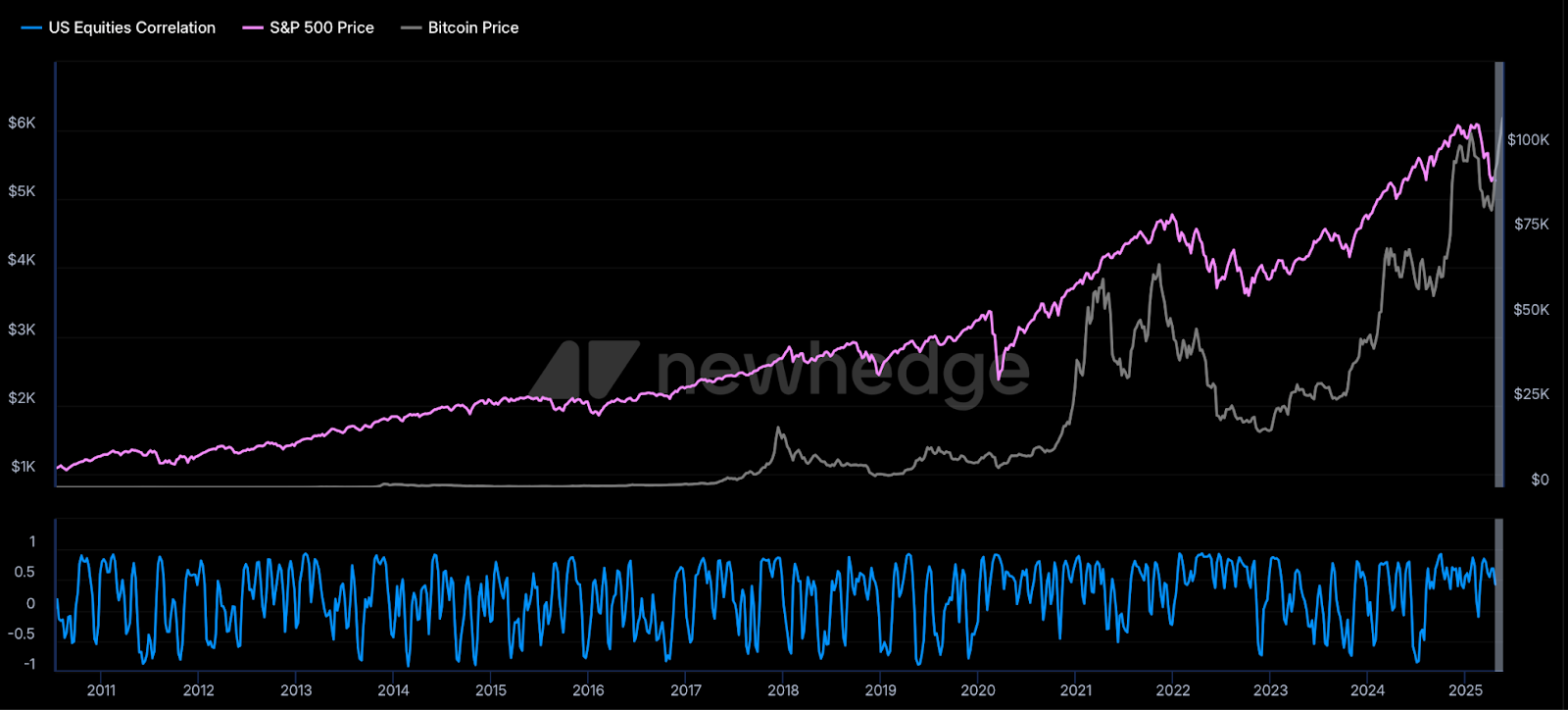Bitcoin
Bitcoin CPI
Venture Portfolio
Funds
Market Insights
Indicators
About
Contact

June 3, 2025





Volatility is one of the most recognizable features of Bitcoin (BTC). After all, 5% to 10% daily price moves aren’t unheard of in the Bitcoin market.
In this guide, we look at what makes Bitcoin so volatile, how this volatility has changed over time, and what tools can help investors make better decisions.
As with the volatility of any other tradable asset, Bitcoin volatility measures BTC’s price swings. The stronger and faster the moves are, the higher the volatility is.
While individual stocks can occasionally move even more than BTC, Bitcoin as an asset class is still, on average, more volatile than, for example, the S&P 500. That’s why Bitcoin is often considered a very volatile asset, even if its volatility has gone down over the years.
The Bitcoin volatility chart is an important tool for investors to track changes in BTC’s volatility so they can make better informed decisions and evaluate risks.
Such charts usually track 30-day and 60-day periods. These windows help smooth out short-term spikes and give a clearer view of overall market conditions.
The volatility line is often shown alongside Bitcoin’s price. The higher the volatility percentage, the less predictable the price of the asset becomes. This means it has been moving more sharply during that time.
The chart helps investors:
Besides occasional stronger spikes, Bitcoin volatility has dropped sharply throughout its history, as the asset class has become more recognized among large traditional institutional investors and new regulated investment products have been introduced to the market.
30-day BTC/USD volatility chart, 2013-2025

Source: CoinGlass
Bitcoin volatility has always jumped during times of uncertainty or strong market moves.
In 2025, for example, BTC 30-day volatility has so far risen to almost 3% only once, in March. This was triggered by news of possible Trump tariffs, which shook not just BTC but traditional markets as well. Investors rushed to take profits or move to safer assets, which caused sharp price swings.
A recent volatile period was during the 2020–2021 bull run. After dropping to around $5,000 in March 2020, Bitcoin climbed to $63,000 by April 2021. That rally was driven by institutional demand and rising retail interest. In February 2021, 30-day volatility hit nearly 6%, right as the prices accelerated.
Bitcoin’s price is influenced by a mix of economic and sentiment-driven factors.
Besides the traditional demand and supply dynamic, the price might change more sharply when reacting to major investor moves, global events, and activity on the BTC derivatives market. However, as the market grows and this asset class matures, the influence of these factors will likely continue to drop, reducing overall Bitcoin volatility.
Bitcoin has a fixed supply of 21 million coins. This built-in scarcity means that a sharp spike in demand can push the price up more easily. Events like the launch of a Bitcoin exchange-traded fund (ETF) or major purchases by companies such as Strategy (former MicroStrategy) can boost the market.
On the flip side, falling interest or large-scale sell-offs can drag the price down fast.
In the past, Bitcoin halving was also considered to be among the key drivers of BTC four-year price cycles. However, as the new Bitcoin issuance is getting halved every four years, it now has reached levels that, compared to the overall size of the market, are too small to make a more considerable impact.
Decisions by the Federal Reserve, inflation levels, geopolitical risks, and stock market trends all play a role. During uncertain times, some investors see Bitcoin as “digital gold” or a safe haven asset. However, other investors still consider it to be more of a risk-off asset, meaning that they’ll sell it first during panic periods.
Political events, such as the US presidential election, can move the market as well, as BTC experienced after the election of Donald Trump, rallying on the market’s hopes that the new administration is going to be more Bitcoin-friendly.
In combination with other data, metrics like exchange reserves, whale wallet activity, and the change in the number of BTC transactions can offer clues about market sentiment. For example, a large outflow of BTC from exchanges may suggest accumulation and expectations of a price increase.
Comments from regulators, such as the US Securities and Exchange Commission, news about a potential ban, or leaks from legislators can move the market as well. While global regulations have become clearer compared to the first years of Bitcoin, investors remain sensitive to regulatory news.
Meanwhile, security breaches, like exchange hacks and collapses, might create panic as well, as happened during the FTX exchange crash. These events might shake market confidence and increase short-term volatility even if the event is not directly related to Bitcoin.
Big investors, including trusts and public companies, have a major impact. When they buy or sell Bitcoin or Bitcoin investment products, the effects are amplified by the size of their capital.
Another growing factor is the decision to launch the Strategic Bitcoin Reserve in the US. This strengthens BTC’s role as an investment and ties it closer to traditional finance.
Bitcoin is usually more volatile than traditional assets like stocks, bonds, commodities, real estate, etc., because investors are already familiar with how these traditional markets operate and how they are regulated.
Meanwhile, Bitcoin, as a relatively new entrant in the global market, still needs to be fully understood by investors, as they often take a more speculative approach rather than one based on the knowledge of the true fundamentals of Bitcoin.
Also, Bitcoin is less liquid than most of the major asset classes, which means large trades can move the market more.
In either case, Bitcoin is usually considered to be somewhat correlated to the stock market, especially tech companies in the Nasdaq 100 index. However, BTC tends to move faster as it trades 24/7. However, during bull and bear markets, Bitcoin starts acting more independently.
Even when BTC and traditional assets move in the same direction, Bitcoin's volatility stays higher for the above-mentioned reasons. That makes it a more unpredictable and riskier asset.
Bitcoin price and S&P 500 comparison

Source: newhedge
Volatility is one of Bitcoin's core features. It creates risk, but opportunity as well. To trade or invest in this market successfully, it's important to understand what moves the price, follow data, and manage risk carefully.
Bitcoin isn't just another asset. It's part of a growing new global financial system where speed, access to information, and adaptability are key.
Bitcoin tends to be most volatile during peak trading hours, especially when both the US and European markets are active. This often happens between 13:00 and 17:00 UTC. Additionally, volatility increases around major news events and price rallies or crashes as the market is trying to balance itself out.
Volatility measures how quickly and how much the price of an asset changes over time. High volatility means wide price swings. For Bitcoin investors, this can be both a major risk and a key attraction.